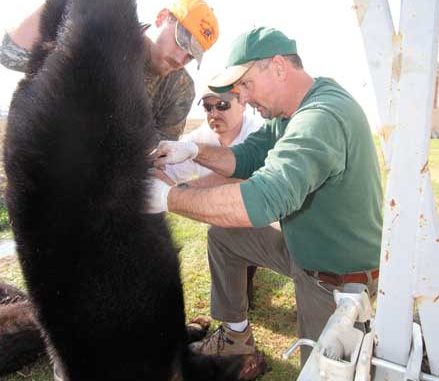
Hunters have become bullish about black bear hunting in northeastern N.C.
The direction of the rifle shot’s muffled report was difficult to gauge. In the mountains, it’s a common expression to say a shot “rang” out, but gunfire echoes are absent because of the thick vegetation in North Carolina’s flatlands.
Minutes later, after an arduous haul, a team of hunters dragged a black bear across a deep ditch and access road built from the ditch’s excavation, providing access to the only open land at the Long Shoal Tract of the N.C. Wildlife Commission’s Gull Rock Game Land.
David Glenn, a 46-year-old heavy-equipment operator from Black Mountain, had made the trek with a large hunting party from the state’s high country to the coast. But black bears are plentiful in the mountains, so why did these western hunters travel to the east to chase bruins?
“It’s the best bear hunting in the world,” said Dale Davis, the WRC’s Northern Coastal game-lands management biologist. “Bear hunters travel a lot. We get bear hunters coming here from other places within North Carolina, as well as from other states because we have such a high bear population.
“There are also several opening dates, depending upon the area of the state you’re hunting, so traveling hunters can take advantage of our various seasons.”
During opening weeks of the state’s major bear seasons, WRC biologists such as Davis are “bullish” on bears, traveling to destinations frequented by bear hunters to gather information from hunter-killed bears. For hunters and biologists northeastern North Carolina constitutes a “bear market” as they take measurements, weights, and a premolar tooth from both sexes of bears and the reproductive tracts from female bears. The information is used to determine the age and condition of bears for making management decisions, such as season lengths for the various counties.
Glenn wiped the sweat from his face with his sleeve, which also came away with leaf litter, grime and a hint of blood from a briar scratch. He had shot the bear with a .44-magnum rifle at 20 feet.
“The hounds had run the bear for 2 ½ hours,” Glenn said. “It’s my 25th bear and I’ve been bear hunting for 26 years.
“But it’s all about the dogs. I like listening to them run.
“Sometimes the bear will tree, but down here, they like to run a long time. In places on the coast there aren’t many trees big enough for a big bear to climb like there are in the mountains so the bear stays on the ground and fights with the dogs a bit, then takes off running again. I couldn’t see very far. The dogs were right on top of the bear when I shot him.”
Bob Glenn, David’s father, is retired. At age 74 he has been bear hunting for more than 50 years.
“If you have dogs, it’s enjoyable to raise and train them,” he said. “When you actually get to hunt, it’s the icing on the cake. Just listening to them run is the fun part. If it doesn’t get you excited just listening to them, you aren’t a bear hunter.
“I would never still-hunt a bear because it’s all about how well your dogs run and tree the bear and whether you can get to the bear to get a shot.”
Davis weighed the bear with the aid of a hoist on his pick-up truck. It weighed 220 pounds dressed and he estimated it had weighed 260 pounds live weight. He said some bears taken in Northeastern N.C. top 600 pounds each season. Rarely, some weigh more than 700 pounds. But anything over 500 pounds is considered a trophy at the coast, while a 300-pound mountain bear is considered a trophy.
“Few mountain bears get as heavy coastal bears,” David Glenn said. “We like to hunt in the mountains, too. But it’s very different terrain down here. The dogs don’t care where they are as long as they can find a bear track.”
The Glenn’s enjoy eating bear meat. They said they fry the liver and smother it with onions. They said it was the best liver of all, especially when it’s fresh. They also like bear meat roasted.
Another hunter in the party was Daniel Bartlett, who works at the post office in Black Mountain. It was his first bear hunt and he was hooked. He had killed his first bear at a range of 15 feet with a 12-gauge slug.
“I was on the ground, trying to get near the dogs when the bear ran straight at me,” Barlett said. “I hit him in the chest and he fell right there. It’s the most exciting hunt I’ve ever been on.”
Butch Parker, a 53-year-old carpenter from Marion had also taken a bear. He was luckier when it came to retrieving his bear than the other hunters.
The hounds had chased his bear into the open and he had taken the bear with a 12-gauge slug as it ran onto the road. He was waiting his turn for Davis to perform an examination of his bear.
“I’m glad the biologists are here,” Parker said. “We called the bear line to let them know we had some bears down so they could come and check them out. They need the information so they can keep up with what’s going on with the population.”
Parker said he had been bear hunting for 25 years and had taken 40 bears in four states. He said a dedicated bear hunter is used to traveling. Since the bag limit in North Carolina is one bear, a hunter who uses his tag may want to go to nearby states to continue hunting. But he also said killing a bear is not what bear hunting is all about.
“It’s a chance to get out and do something with your buddies,” he said. “It’s everyone getting the chance to run their dogs. Bear hunting is a group event. If you get a big bear and he’s way back in the swamp, you could never get him out alone.”
Davis said the WRC’s Division of Enforcement allows the use of its toll-free number during the initial weeks of the mountain and coastal bear seasons. A call to the dispatcher goes out to the biologists in the field. The cooperative arrangement results in about half the total statewide kill, or approximately 1,000 bears, being examined each season.
“It’s almost a mark of honor for a bear hunter to receive our Bear Cooperator cap for allowing us to examine a bear,” Davis said. “Besides, hunters judge the trophy value of a bear by the weight, not necessarily the skull, like the national organizations. It’s easier for hunters to have us bring the scales to them in the field than to weigh them themselves, especially if it’s a really big bear.”
With the escalating bear population along the coast and bears in that region attaining a legendary status when it comes to size, the prices of bear hunting leases on private land has become very expensive. Landowners realize the value of their biggest wildlife crop and are recovering the loss of grain crops in their fields to bears by leasing their lands to bear hunters.
“There were once few bears and few bear hunters,” Davis said. “But now these northeastern counties are some of the most crowded places in the state when it comes to hunters for just those few days during bear season. The Commission has lots of game lands that have plenty of bears. But we’ve had to restrict the number of hunting days in many of them, to where they are even shorter than brief hunting seasons we allow on private lands.”
Davis said several different management plans offer different menus when it comes to hunting days during the northeastern region’s bear seasons. A bear hunt on public land should therefore begin with some homework.
“People must be aware that there are many different bear hunting seasons at the coast,” Davis said. “The first thing they should do is go to a Game Lands map book or map section on the Commission’s website and identify the game land where they want to hunt to see if it or any part of it is a bear sanctuary.
“Some game lands are part sanctuary like Gull Rock. Some are all sanctuary and some are entirely open for bear hunting. After that, they must check the Regulations Digest or the regulations section online to find the hunting dates. Some have bear hunting dates more restrictive than the bear hunting seasons for the counties they are located in.”
Alligator River GL is located 8 to 10 miles east of Columbia. An additional 9,000 acres called the GMS Tract was recently added, creating a total acreage of 13,877. Alligator River has a good bear population and has some roads for good access.
It’s in Tyrrell County in the heart of bear country. It fronts Alligator River and Second Creek. The original tract was lowland with cypress and other wet hardwoods. But the new addition has upland habitat and pine plantations and cutovers. There is some agriculture within a mile of the south side.
Buckridge GL in Tyrrell County has 18,194 acres along the Alligator River and is located 10 miles south of Alligator River GL. It has numerous roads and trails for good access. Davis said keeping some roads gated on game lands such as Buckridge irritated a few hunters.
But he said closing certain roads to vehicles helped enhance wildlife habitat and keeps down maintenance costs on roads constructed of organic soils. Buckridge GL is low and wet land with cypress and gum swamp. It’s been extremely dry over the last year and water levels are down for above average hunting access.
Chowan Swamp GL is 25,516 acres of upland and swamp habitat in Bertie, Gates and Hertford counties. It has a good bear population with excellent land access but can also be accessed from the Chowan River by boat.
Gull Rock GL has two tracts, with about 9,000 of its 34,346 acres open for bear hunting. The Carter Tract has no road access and must be accessed from the ICW. The Long Shoal Tract has good roads but difficult hunting because of the pocosin habitat.
Van Swamp GL has 5,482 acres in Washington and Beaufort counties.
Van Swamp, Alligator River and Chowan Swamp offer some opportunities for still-hunting bears because they have some upland terrain.
“The next category are Game Lands open along with the county seasons,” Davis said. “They are open for bear hunting one week in November and two weeks in December. Bertie GL has 4,090 acres, with areas on Cashie River that have only water access. The Johnson Landing Tract is part of our recent International Paper purchase and has some pine plantation and some oak forest. No centerfire rifles are allowed there.”
Bachelor Bay Game Land, in Bertie, Martin and Washington has 4,470 acres of mostly bear sanctuary. But a tract in Martin County is open for bear hunting and only has water access along the Roanoke River. It’s bottomland habitat with a good bear population but tough hunting.
Lantern Acres is 1,825 acres in two tracts in Washington and Tyrrell counties. The larger tract adjoins Pocosin Lakes NWR. Bear hunters have difficulty using hounds because they run bears from the small game land onto the refuge where bear hunting is prohibited.
Dare GL has two dog hunts and two still-hunts for bears annually conducted by permit only. It has an excellent bear population providing an excellent opportunity to kill a bear and have a quality hunt. Davis is bullish on the opportunities the success at the U.S. Air Force property being used as a blueprint for NWR lands or other lands where bear hunting is not currently allowed.
“We are hopeful of being able to use Dare GL as a model for opening other areas currently closed to bear hunting,” Davis said. “It took cooperation on the part of the Air Force, local officials and bear hunting groups to make the Dare GL hunt happen.”

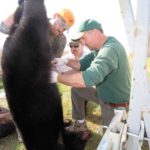
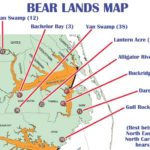
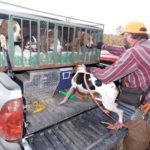
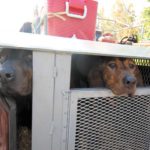



Be the first to comment